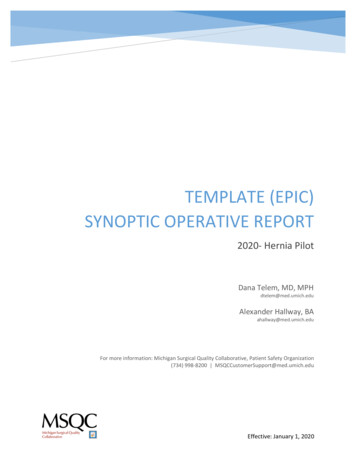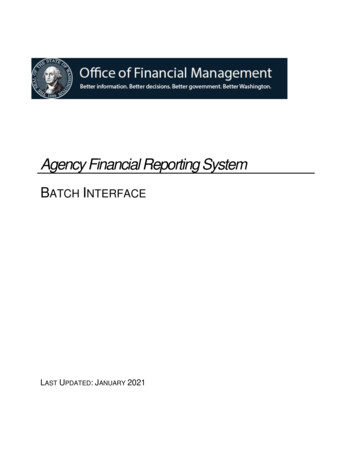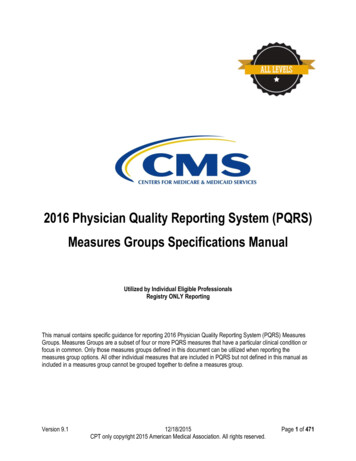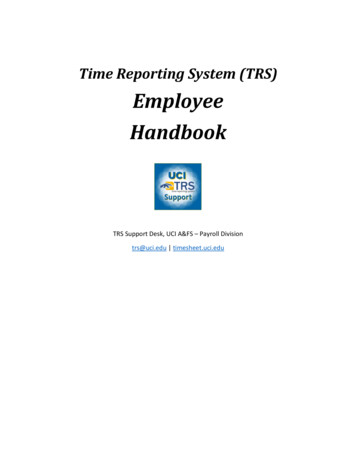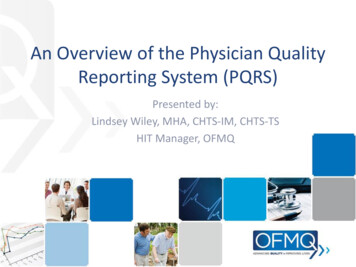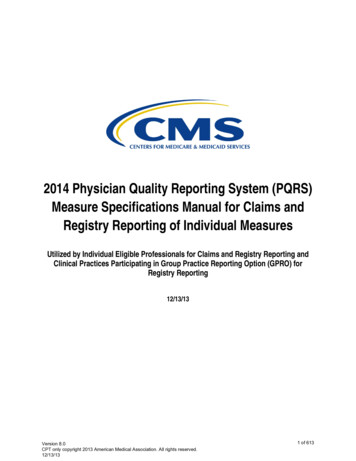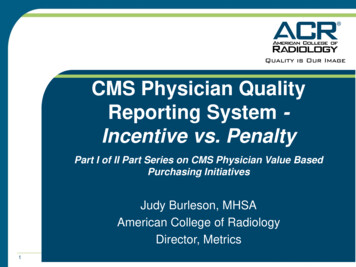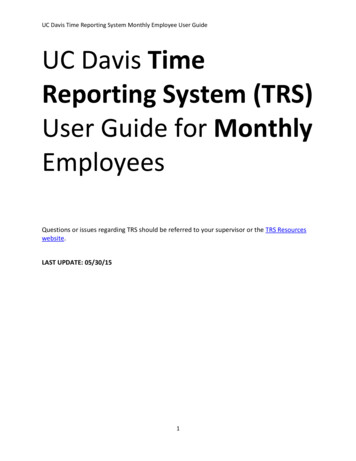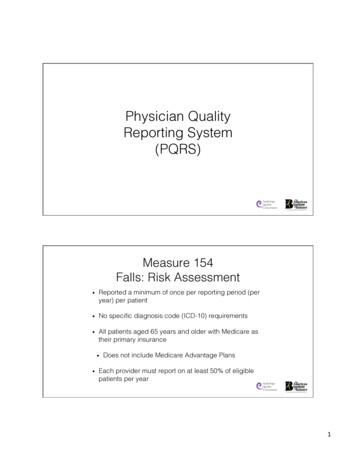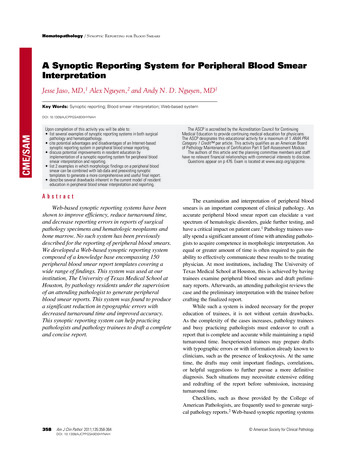
Transcription
Hematopathology / Synoptic Reporting for Blood SmearsA Synoptic Reporting System for Peripheral Blood SmearInterpretationJesse Jaso, MD,1 Alex Nguyen,2 and Andy N. D. Nguyen, MD1Key Words: Synoptic reporting; Blood smear interpretation; Web-based systemCME/SAMDOI: 10.1309/AJCPPGSA9D0HYNAHUpon completion of this activity you will be able to: list several examples of synoptic reporting systems in both surgicalpathology and hematopathology. cite potential advantages and disadvantages of an Internet-basedsynoptic reporting system in peripheral blood smear reporting. discuss potential improvements in resident education byimplementation of a synoptic reporting system for peripheral bloodsmear interpretation and reporting. list 2 examples in which morphologic findings on a peripheral bloodsmear can be combined with lab data and preexisting synoptictemplates to generate a more comprehensive and useful final report. describe several drawbacks inherent in the current model of residenteducation in peripheral blood smear interpretation and reporting.AbstractWeb-based synoptic reporting systems have beenshown to improve efficiency, reduce turnaround time,and decrease reporting errors in reports of surgicalpathology specimens and hematologic neoplasms andbone marrow. No such system has been previouslydescribed for the reporting of peripheral blood smears.We developed a Web-based synoptic reporting systemcomposed of a knowledge base encompassing 150peripheral blood smear report templates covering awide range of findings. This system was used at ourinstitution, The University of Texas Medical School atHouston, by pathology residents under the supervisionof an attending pathologist to generate peripheralblood smear reports. This system was found to producea significant reduction in typographic errors withdecreased turnaround time and improved accuracy.This synoptic reporting system can help practicingpathologists and pathology trainees to draft a completeand concise report.358358Am J Clin Pathol 2011;135:358-364DOI: 10.1309/AJCPPGSA9D0HYNAHThe ASCP is accredited by the Accreditation Council for ContinuingMedical Education to provide continuing medical education for physicians.The ASCP designates this educational activity for a maximum of 1 AMA PRACategory 1 Credit per article. This activity qualifies as an American Boardof Pathology Maintenance of Certification Part II Self-Assessment Module.The authors of this article and the planning committee members and staffhave no relevant financial relationships with commercial interests to disclose.Questions appear on p 476. Exam is located at www.ascp.org/ajcpcme.The examination and interpretation of peripheral bloodsmears is an important component of clinical pathology. Anaccurate peripheral blood smear report can elucidate a vastspectrum of hematologic disorders, guide further testing, andhave a critical impact on patient care.1 Pathology trainees usually spend a significant amount of time with attending pathologists to acquire competence in morphologic interpretation. Anequal or greater amount of time is often required to gain theability to effectively communicate these results to the treatingphysician. At most institutions, including The University ofTexas Medical School at Houston, this is achieved by havingtrainees examine peripheral blood smears and draft preliminary reports. Afterwards, an attending pathologist reviews thecase and the preliminary interpretation with the trainee beforecrafting the finalized report.While such a system is indeed necessary for the propereducation of trainees, it is not without certain drawbacks.As the complexity of the cases increases, pathology traineesand busy practicing pathologists must endeavor to craft areport that is complete and accurate while maintaining a rapidturnaround time. Inexperienced trainees may prepare draftswith typographic errors or with information already known toclinicians, such as the presence of leukocytosis. At the sametime, the drafts may omit important findings, correlations,or helpful suggestions to further pursue a more definitivediagnosis. Such situations may necessitate extensive editingand redrafting of the report before submission, increasingturnaround time.Checklists, such as those provided by the College ofAmerican Pathologists, are frequently used to generate surgical pathology reports.2 Web-based synoptic reporting systems American Society for Clinical Pathology
Hematopathology / Original Article Table 1 Pathologic Findings in Peripheral Blood Smears Image 1 Data input panel, allowing user to select relevantfindings from the peripheral blood smear. CLL, chroniclymphocytic leukemia; CML, chronic myelogenous leukemia;DIC, disseminated intravascular coagulation; ET, essentialthrombocythemia; ITP, immune thrombocytopenic purpura;PLT, platelets; PMNs, polymorphonuclear leukocytes; TTP/HUS, thrombotic thrombocytopenic purpura/hemolyticuremic syndrome.that incorporate such checklists have been shown to improveefficiency, reduce turnaround time, and decrease reportingerrors.3 Synoptic systems for hematologic neoplasms andbone marrow reporting have also been described with similarresults.4,5 To date, such a system has not been described forthe reporting of peripheral blood smear findings.We developed a Web-based synoptic reporting programto assist in peripheral blood smear reporting. This programhas a knowledge base containing 150 peripheral blood smearreport templates covering a wide spectrum of pathologic findings. Users can access this system on the Internet and selectrelevant attributes from drop-down lists to obtain a short listof report templates with findings that match those of the caseunder consideration. These templates are used to create a preliminary draft that can then be edited online to create a finalreport. We believe that practicing and training pathologistscould benefit from such a system that aids in peripheral bloodsmear reporting while allowing the instruction of trainees.Findings on erythrocytesIron deficiency anemiaAnemia of chronic diseaseIncreased erythropoiesis in response to anemiaIron deficiency anemia in response to iron treatmentAnemia in response to epoetin alfa treatment:β-Thalassemia trait cannot be ruled outB12/folate deficiencyMacrocytosis secondary to medicationPolycythemia“Sickling” diseaseSickle cell disease in crisisWarm autoantibodyWarm autoantibody cannot be ruled outCold agglutininMicroangiopathic hemolysisThrombotic thrombocytopenic purpura/hemolytic uremic syndromeDisseminated intravascular coagulationMicroangiopathic hemolysis cannot be ruled outHereditary spherocytosisNonmicrospherocytic hemolysisHereditary elliptocytosis cannot be ruled outFindings on leukocytesLeukocytosis with a few reactive lymphocytesLeukocytosis with reactive polymorphonuclear leukocytesLeukemoid reactionReactive neutrophiliaReactive eosinophiliaLeukopeniaHistoplasma capsulatumChronic lymphocytic leukemia/other lymphoproliferative disordersChronic myelogenous leukemiaAcute leukemiaMyeloproliferative disorderImmature leukocytesFindings on plateletsReactive thrombocytosisMarked thrombocytosis (cannot rule out essential thrombocythemia)ITPITP and blood loss with increased erythropoiesisSpurious thrombocytopeniaOther findingsPancytopenia due to inadequate hematopoiesis by bone marrowLiver diseaseRenal diseaseRouleaux formationRouleaux formation due to monoclonal gammopathyNo pathologic changesNormal/premature newbornHypothyroidismITP, immune thrombocytopenic purpura.Design and MethodsA closer look at the system and an example session follow.DesignThe user interface consists of 2 components: data inputpanel and report template display. The data input panel Image1 contains 45 typical findings categorized into 5 groups forease of input: (1) erythrocytes, (2) hemolysis, (3) leukocytes,(4) platelets, and (5) other miscellaneous findings. The list ofthese findings is tabulated in Table 1 . The report templatedisplay Image 2 represents an editable window in which the American Society for Clinical PathologyAm J Clin Pathol 2011;135:358-364359DOI: 10.1309/AJCPPGSA9D0HYNAH359359
Jaso et al / Synoptic Reporting for Blood Smearsreport templates (anywhere from 1 to 5) are displayed. Thesetemplates are extracted from reports in the knowledge base ofthe system. The extracted templates are actual reports of previous cases with findings and interpretations most resemblingthe case under consideration.The Knowledge BaseThe knowledge base is a repertoire of 150 selectedreports previously issued for patient care in the laboratory ofThe University of Texas Medical School at Houston. Theyrepresent typical reports, which cover a wide spectrum ofclinical findings. As new cases with particular findings areencountered during sign-out, they are selectively added to theknowledge base for future use.This system is designed to help users create an optimumreport in a short time using preexisting templates convenientlyavailable on the Internet. The templates encompass specificperipheral blood smear findings and describe the findings ina manner that is designed to be comprehensive yet concise.When appropriate, the templates also include additionalinformation regarding potential differential diagnoses andsuggestions for further workup. For example, a templatereporting the presence of thrombocytopenia, increased schistocytes, and polychromasia would include the presence ofmicroangiopathic hemolytic anemia in the differential diagnosis and advise the clinician to check the coagulation statusof the patient and rule out evidence of hemolysis Image 3 .In this manner, clinicians receive a comprehensive report andguidance for further workup and management. The templatesalso allow pathologists or trainees to incorporate preexistinglaboratory data in the report. For example, a template for acase with hypochromic normocytic anemia may include adifferential diagnosis of iron deficiency anemia vs anemia ofchronic disease. However, if an iron panel has been performedin clinical chemistry, a different template can be chosen incorporating the results Image 4 . These templates are designedto aid in crafting the report and are not intended to replacecareful examination of the blood smear. A final report is givenonly after the user, alone or under the guidance of an attendingpathologist, has found all pertinent pathologic findings in theperipheral blood smear. Image 2 Report template display window. Preexistingtemplates appear after the user has selected findings andclicks “Get Report Now.”Example SessionA typical session with the system is shown in Image5 , Image 6 , and Image 7 . In this session, the user enteredthe following findings: presence of a warm autoantibody, Image 3 Example of a template displaying informationregarding further workup in a patient with possiblemicroangiopathic hemolytic anemia. CPT, Current ProceduralTerminology code; DIC, disseminated intravascular coagulation;FSP, fibrin split products; LDH, lactate dehydrogenase; PMNs,polymorphonuclear leukocytes; PT, prothrombin time. Image 4 Example of a template combining peripheralblood smear findings and iron panel results. CPT, CurrentProcedural Terminology code.360360Am J Clin Pathol 2011;135:358-364DOI: 10.1309/AJCPPGSA9D0HYNAH American Society for Clinical Pathology
Hematopathology / Original Articlereactive leukocytosis, and thrombocytosis (Image 5). Thereport templates are extracted by clicking the “Get ReportNow” button. The appropriate report templates are extractedfrom the knowledge base and are displayed in the report template display window (Image 6). These templates contain relevant information associated with the input data and pertinentcorrelation and interpretation. Note that some templates maycontain only 1 or 2 of the selected findings or sometimes morethan 3 selected findings. This allows for more available information to be used in compiling the draft. Since archived templates rarely correspond exactly to all details of the case underconsideration, the user needs to edit one or more templatesin the display window to compile the draft for the report. Allediting events can be done directly in the display windowwithout affecting the archived templates for subsequent use.Large amounts of free text can also be added for cases needing information not available in the templates. Image 7 showsthe appearance of a final draft after the addition of free textand extensive editing of the templates. The user can then copythe final draft from the display window and paste it into theediting buffer in the laboratory information system (LIS) forreporting purposes.As shown in the preceding examples, the synoptic reporting system is designed with a user-friendly interface. Thisgraphic user interface is arranged such that the sequence ofdata entry, display of report templates, and editing of templates should be intuitive to users.Methods (Software Platform)This Web-based synoptic reporting system is implemented in hypertext markup language (HTML), a conventional Image 6 The report template display window imports severaltemplates incorporating the findings in Image 5. CPT, CurrentProcedural Terminology code; DAT, direct antiglobulin test;LDH, lactate dehydrogenase; PMNs, polymorphonuclearleukocytes. Image 5 User has selected several peripheral blood smearfindings, including the presence of a warm autoantibody,reactive leukocytosis, and reactive thrombocytosis. CLL,chronic lymphocytic leukemia; CML, chronic myelogenousleukemia; DIC, disseminated intravascular coagulation; ET,essential thrombocythemia; ITP, immune thrombocytopenicpurpura; PLT, platelets; PMNs, polymorphonuclearleukocytes; TTP/HUS, thrombotic thrombocytopenic purpura/hemolytic uremic syndrome. Image 7 The user has crafted a final report after extensiveediting of the templates from Image 6. CPT, CurrentProcedural Terminology code; DAT, direct antiglobulin test;LDH, lactate dehydrogenase; PMNs, polymorphonuc
The ASCP designates this educational activity for a maximum of 1 AMA PRA Category 1 Credit per article. This activity qualifies as an American Board of Pathology Maintenance of Certification Part II Self-Assessment Module. The authors of this article and the planning committee members and staff have no relevant financial relationships with commercial interests to disclose. Questions appear .
